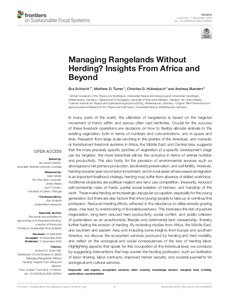| dcterms.abstract | In many parts of the world, the utilization of rangelands is based on the targeted movement of herds within and across often vast territories. Crucial for the success of these livestock operations are decisions on how to flexibly allocate animals to the existing vegetation, both in terms of numbers and concentrations, and in space and time. Research from large scale ranching in the prairies of the Americas, and nomadic or transhumant livestock systems in Africa, the Middle East, and Central Asia, suggests that the more precisely specific patches of vegetation at a specific development stage can be targeted, the more beneficial will be the outcome in terms of animal nutrition and productivity. This also holds for the provision of environmental services such as aboveground net primary production, biodiversity preservation, and soil fertility. However, herding requires year-round labor investment, and in rural areas where seasonal migration is an important livelihood strategy, herding may suffer from absence of skilled workforce. Additional obstacles are political neglect and land use competition, insecurity, reduced self-ownership rates of herds, partial social isolation of herders, and hardship of the work. These make herding an increasingly unpopular occupation, especially for the young generation, but there are also factors that drive (young) people to take up or continue this profession. Reduced herding efforts, reflected in the reluctance to utilize remote grazing areas, may lead to overstocking of favorable pastures. This increases the risk of pasture degradation, long-term reduced herd productivity, social conflict, and public criticism of pastoralism as an anachronistic lifestyle and detrimental land stewardship, thereby further fueling the erosion of herding. By reviewing studies from Africa, the Middle East, and southern and eastern Asia, and including some insights from Europe and southern America, we discuss the ecosystem services produced by herding and herd mobility, and reflect on the ecological and social consequences of the loss of herding labor. Highlighting aspects that speak for this occupation at the individual level, we conclude by suggesting interventions that may sustain the herding profession, such as facilitation of labor sharing, labor contracts, improved herder security, and societal payments for ecological and cultural services. | eng |


